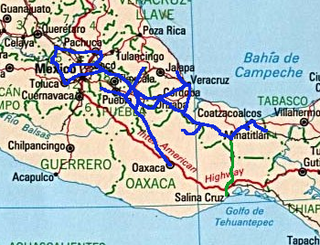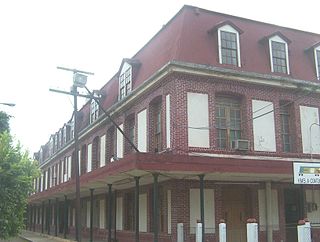Related Research Articles

Buenavista is a station on the Mexico City Metro, in the Colonia Buenavista neighborhood of the Cuauhtémoc borough. It is the southwestern terminal station of Line B. It also offers connections to the Insurgentes Metrobús bus rapid transit line. In 2019, the station had an average ridership of 66,804 passengers per day, making it the tenth busiest station in the network.

The Ferrocarril del Istmo de Tehuantepec(Ferrocarril del Istmo de Tehuantepec, S.A. de C.V.), also known as Tren Interoceánico, Line Z, Ferrocarril Transístmico or simply Ferroistmo, is part of the Interoceanic Corridor of the Isthmus of Tehuantepec, owned by the Mexican government, that crosses the Isthmus of Tehuantepec between Puerto Mexico, Veracruz, and Salina Cruz, Oaxaca. It is leased to Ferrocarril del Sureste FERROSUR.

Eduardo Molina metro station is a Mexico City Metro station within the limits of Gustavo A. Madero and Venustiano Carranza, in Mexico City. It is an at-grade station with one island platform, served by Line 5, between Consulado and Aragón stations. Eduardo Molina station serves the colonias (neighborhoods) of 20 de Noviembre and Malinche. The station is named after Eduardo Molina Arévalo, an engineer who helped to solve the problem of water scarcity in the Valley of Mexico in the mid-20th century, and its pictogram represents two hands holding water, as featured on the mural El agua, origen de la vida, painted by Mexican muralist Diego Rivera in the Cárcamo de Dolores, in Chapultepec, Mexico City. Eduardo Molina metro station was opened on 19 December 1981, on the first day of the Consulado–Pantitlán service. In 2019, the station had an average daily ridership of 6,811 passengers, making it the 176th busiest station in the network and the ninth busiest of the line.

Buenavista Station, also called Buenavista Terminal, was a passenger train station in Mexico City. The station opened in 1873 and since 1909, the station was fully operated by Ferrocarriles Nacionales de México. The station was closed in 2005. By June 2008, the station was replaced by the terminus of the Tren Suburbano commuter rail service.

The Mexibús Line I is a bus rapid transit (BRT) line in the Mexibús system. It operates between Felipe Ángeles International Airport in Zumpango, Ojo de Agua in Tecámac and Ciudad Azteca in Ecatepec de Morelos. It was the first line to be built and to be opened. It was inaugurated by the governor of the State of Mexico, Enrique Peña Nieto on 1 December 2010 with 24 stations. Another station was opened later. It is 20 kilometers (12 mi) long and was used by approximately 130,000 users per day during 2012. The line has four different types of services, including a service exclusive for women and children. The line operates with 75articulated Volvo 7300 BRT buses painted white with red, light green and dark green trim. It began free operations in October 2010.

The Interoceanic Corridor of the Isthmus of Tehuantepec, abbreviated as CIIT, is a trade and transit route in Southern Mexico, under the control of the Secretariat of the Navy, which connects the Pacific and Atlantic Oceans through a railway system, the Ferrocarril del Istmo de Tehuantepec, for both cargo and passengers, crossing through the Isthmus of Tehuantepec. This project also consists on the modernization and growth of local seaports, particularly the ports of Salina Cruz (Oaxaca) and Coatzacoalcos (Veracruz), and of the Minatitlán oil refinery and the Salina Cruz oil refinery. In addition, it plans to attract private investors through the creation of 10 industrial parks in the Isthmus area, as well as two other parks in Chiapas. The project has the goal of developing the economy and industry of the Mexican South through encouraging economic investment, both national and international, and facilitate commerce and transportation of goods internationally.
Coatzacoalcos is a planned railway station located in Coatzacoalcos, Veracruz.
Candelaria is a future train station located in Candelaria, in the Mexican state of Campeche. Candelaria connects with Campeche and Yucatán.
Line K, also known as the Ixtepec–Ciudad Hidalgo Line, is a railroad owned by the Mexican government that connects Ixtepec, Oaxaca with Ciudad Hidalgo, Chiapas. It was leased to the Ferrocarril Chiapas-Mayab. President Andrés Manuel López Obrador announced that the Mexican government will rehabilitate the line from Ixtepec, Oaxaca to Ciudad Hidalgo, Chiapas.

Jesús Carranza station is a train station in Jesús Carranza, Veracruz.
Donají is a railway station in Donají, Oaxaca.
Mogoñé is a train station in San Juan Guichicovi, Oaxaca.

Matías Romero is a train station in Matías Romero, Oaxaca.
Ixtepec is a train station located in Ciudad Ixtepec, Oaxaca.

Salina Cruz is a railway station in Salina Cruz, Oaxaca.
Mapastepec is a former and future railway station in Mapastepec, Chiapas.
Villa Comaltitlán is a former and future railway station in Villa Comaltitlán, Chiapas.
Huixtla is a former and future railway station in Huixtla, Chiapas. The building is unique to this region, because it is made from bricks and mud tile roof.

The Interoceanic Train of the Isthmus of Tehuantepec is a government-owned railway system in Mexico that has 3 lines. It seeks to become a global logistics network focused on the manufacture and movement of goods between the Pacific Ocean and the Atlantic Ocean through the Isthmus of Tehuantepec.
Chivela is a train station located in Chivela, Asunción Ixtaltepec, Oaxaca.
References
- 1 2 "Medias Aguas". Secretaría de Cultura/Sistema de Información Cultural (in Spanish). Retrieved 2023-08-29.
- 1 2 "México tiene tren para pasar a los dos grandes océanos, destaca AMLO en Salina Cruz". SinEmbargo MX (in Spanish). 22 December 2023. Retrieved 22 December 2023.
- 1 2 Varela, Micaela (22 December 2023). "López Obrador echa a andar el tren Interoceánico que unirá el golfo de México con el Pacífico". El País México (in Mexican Spanish). Retrieved 22 December 2023.
- ↑ "Revive Medias Aguas con empleos y seguridad mediante el FIT". Imagen de Veracruz (in Mexican Spanish). Retrieved 24 September 2023.
- ↑ "¡También en el sur de Veracruz! Toma Semar estación de Medias Aguas". Imagen del Golfo (in Mexican Spanish). Retrieved 24 September 2023.
- ↑ "Reabrirán paso ferroviario Medias Aguas-Estación Uvero". Diario del Istmo (in Mexican Spanish). Retrieved 24 September 2023.